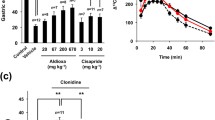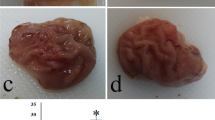Abstract
Exogenous prostaglandins inhibit visible gastric muscosal lesions produced by both absolute ethanol and cold restraint in the rat. Pretreatment with “mild irritants” significantly reduces the magnitude of ethanol-induced lesions presumably by stimulating endogenous prostanoid production. The effect of mild irritant pretreatment on cold restraint-induced lesion formation has not been previously reported. This study was designed to compare the protective effect of pretreatment with two “mild irritants,” 4% NaCl and 0.35 M HCl, and the synthetic prostanoid, 16,16 dimethyl PGE2)16,16-dm PGE2), on lesions produced by cold restraint or absolute ethanol. Pretreatment with both mild irritants produced complete visible protection against ethanol-induced injury but had variable effects against cold restraint-induced injury. Whereas 5 μg/kg 16,16-dmPGE2 provided complete visible protection against ethanol-induced injury, 20 μg/kg 16,16-dmPGE2 was required for complete visible protection against cold restraint-induced injury. We conclude that prostaglandin requirements for protection against cold restraint injury are greater than for protection against ethanol-induced gastric mucosal injury.
Similar content being viewed by others
References
Robert A, Nezamis JE, Lancaster C, Hanchar A: Cytoprotection by prostaglandins in rats: Prevention of gastric necrosis produced by alcohol, HCl, NaOH, hypertonic NaCl, and thermal injury. Gastroenterology 77:433–443, 1979
Senay EC, Levine RJ: Synergism between cold and restraint for rapid production of stress ulcers in rats. Proc Soc Exp Biol Med 124:1221–1223, 1967
Lacy ER, Ito S: Microscopic analysis of ethanol damage to rat gastric mucosa after treatment with a prostaglandin. Gastroenterology 83:619–625, 1982
Goldman H, Rosohoff CB: Pathogenesis of acute gastric stress ulcers. Am J Pathol 52:227–236, 1968
Mersereau WA, Hinchey J: Hypothermia-induced gastric hypercontractility in the genesis of the restraint ulcer. Can J Surg 24:622–625, 1981
Karawada Y, Lambek J, Matsumoto T: Pathophysiology of stress ulcer and its prevention. II Prostaglandin E and microcirculatory responses in stress ulcer. Am J Surg 129:217–222, 1975
Robert A, Lancaster C, Hanchar AJ, Nezamis JE: Mild irritants prevent gastric necrosis through prostaglandin formation: A histological study. Gastroenterology 74:1086, 1978 (abstract)
Robert A, Nezamis JE, Lancaster C, Davis JP, Field SO, Hanchar J: Mild irritants prevent gastric necrosis through “adaptive cytoprotection” mediated by prostaglandins. Am J Physiol 245:G113-G121, 1983
Chaudhury TK, Robert A: Prevention by mild irritants of gastric necrosis produced in rats by sodium taurocholate. Dig Dis Sci 25:830–836, 1980
Hanson HM, Brodie DA: Use of the restrained rat technique for study of the anti-ulcer effect of drugs. J Appl Physiol 15:291–294, 1960
Watanabe K: Some pharmacological factors involved in formation and prevention of stress ulcer in rats. Chem Pharmacol Bull 14:101–107, 1966
Goto Y, Watanabe K: Inhibitory mechanism of calcitonin on vagally induced gastric acid secretion in the rat in relation to its antiulcer activity.In Advances in Experimental Ulcer. S Umehara, H Ito (eds). Tokyo, ICEU Press, 1980, pp 337–347
Menguy R: Effect of restraint stress on gastric secretion in the rat. Am J Dig Dis 11:911–916, 1960
Dai S, Ogle CW: Gastric ulcers induced by acid accumulation and by stress in pylorus-occluded rats. Eur J Pharmacol 26:15–21, 1974
Levine BA, Sirinek KR, Pruitt BA: Cimetidine protects against stress-induced gastric injury augmented by mucosal barrier breakers. Am J Surg 137(3):328–331, 1979
Davenport HW: Physiology of the Digestive Tract, Year Book Medical Publ., Chicago, 1977, p 124
Robert A: Prostaglandins and the gastrointestinal tract.In Physiology of the Gastrointestinal Tract. LR Johnson (ed). New York, Raven Press, 1981, pp 1407–1434
Watanabe K, Goto Y, Nobuyuki H: Continous measurement of gastric bleeding in the rat subjected to restraint and water-immersion stress.In Advances in Experimental Ulcer. S Umehara, H Ito (eds). Japan, ICEU, 1981, pp 82–88
Robert A, Schultz JR, Nezamis JE, Lancaster E: Gastric antisecretory and antiulcer properties of PGE2, 15-methyl PGE2 and 16,16-dimethyl PGE2. Gastroenterology 70:359–370, 1976
Yano S, Akahane M, Harada N: Role of gastric motility in the development of stress induced gastric lesions of rats. Jpn J Pharmacol 28:607–615, 1978
Chawla RC, Eisenberg MM: Prostaglandin inhibition of denervated antral motility in dogs. Proc Sci Exp Biol Med 132:1081–1086, 1969
Sanders KM: Endogenous prostaglandin E and contractile activity of isolated ileal smooth muscle. Am J Physiol 3(2):E209-E212, 1978
Sanders KM, Szurszewski JH: Does endogenous prostaglandin affect gastric antral motility. Am J Physiol 241:G191-G195, 1981
Svanes K, Critchlow J, Takeuchi K, Magee S, Ito S, Silen W: Factors influencing reconstitution of frog gastric mucosa: role of prostaglandins.In Mechanisms of Mucosal Protection in the Upper Gastrointestinal Tract. A Allan, Flemstrom G, Garner A, Silen W, Turnberg LA (eds). New York, Raven Press, 1984, pp 33–40
Basso N, Materia A, Forlini A, Jaffe BM: Prostaglandin generation in the gastric mucosa of rats with stress ulcer. Surgery 94:104–108, 1983
Konturek S, Brzozowski T, Piastucki I, Radecki T, Dembinski A, Dembinska-kiec A: Role of locally generated prostaglandins in adaptive gastric cytoprotection. Dig Dis Sci 27:967–971, 1982
Robert A, Lancaster JE, Nezamis JE, Davis JP, Field SO: Mild irritants stimulate prostaglandin synthesis by the gastric mucosa: Mechanism of adaptive cytoprotection. Gastroenterology 84:A28, 1983 (abstract)
Okabe S, Takeuchi K, Kunimi H, Kanno M, Kawashima M: Effects of an antiulcer drug, sucralfate (a basic aluminum salt of sulfated disaccharide), on experimental gastric lesions and gastric secretion in rats. Dig Dis Sci 28:1034–1042, 1983
Author information
Authors and Affiliations
Additional information
This work was supported by National Institutes of Health grants BRSG 4-434400-32602, NIADDK AM 27465 and AM 17328.
Rights and permissions
About this article
Cite this article
Garrick, T., Kolve, E. & Kauffman, G.L. Prostaglandin requirements are greater for protection in cold restraint-induced than alcohol-induced gastric mucosal injury. Digest Dis Sci 31, 401–405 (1986). https://doi.org/10.1007/BF01311676
Received:
Revised:
Accepted:
Issue Date:
DOI: https://doi.org/10.1007/BF01311676




